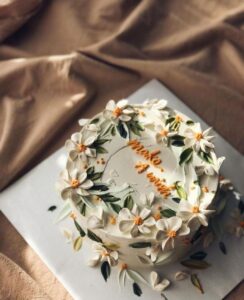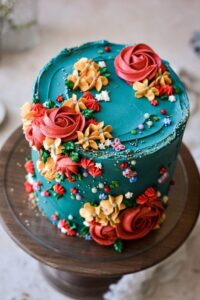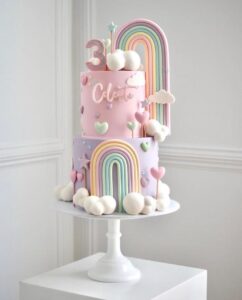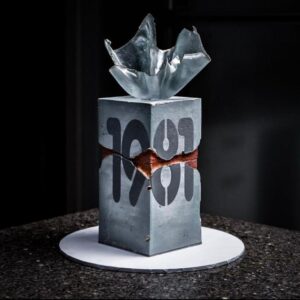Cake design: Inspiring Design Delights
Crafting Edible Art: A Journey into Cake Design
Cakes have always held a special place in our hearts and on our tables. Beyond being a delicious dessert, cake design is a canvas for creativity, a symbol of celebration, and a way to express love and joy. Whether it’s a towering wedding cake adorned with intricate sugar flowers or a whimsical birthday cake featuring a favorite character, cake design is an art form that brings sweetness to life. In this blog, we’ll take a deep dive into the world of cake design, exploring its history, techniques, and the boundless possibilities it offers.
Types of cakes you need to know
Here are some unique types of cake that go beyond the traditional chocolate and vanilla:
- Matcha Green Tea Cake: A delicate and earthy cake made with matcha (green tea) powder, often paired with light, sweet frosting like white chocolate or a matcha-infused cream.
- Tiramisu Cake: A twist on the classic Italian dessert, this cake features layers of coffee-soaked sponge cake, mascarpone cheese, and a dusting of cocoa powder.
- Chai Spice Cake: Infused with the warm and aromatic spices of chai tea, this cake is a delightful blend of cinnamon, cardamom, cloves, and ginger.
- Avocado Lime Cake: A unique and vibrant cake made with ripe avocados and lime zest, resulting in a moist and tangy dessert.
- Balsamic Strawberry Cake: This cake combines the sweetness of fresh strawberries with a drizzle of balsamic reduction for a complex and slightly tart flavor profile.
- Honey Lavender Cake: A delicate and aromatic cake featuring lavender-infused honey for a subtle floral taste.
- Black Sesame Cake: A cake made with ground black sesame seeds, giving it a nutty, toasty flavor and an attractive dark color.
- Pandan Chiffon Cake: Pandan leaves lend this cake a unique flavor and vibrant green color, popular in Southeast Asian desserts.
- Taro Cake: Made from taro root, this cake has a sweet, nutty, and slightly earthy flavor and is often used in Asian desserts.
- Cassata Cake: A traditional Sicilian dessert, cassata cake features sponge cake soaked in liqueur and layered with sweet ricotta cheese and candied fruits.
- Rose Water and Pistachio Cake: Fragrant rose water complements the nuttiness of pistachios in this elegant cake.
- Mango Sticky Rice Cake: Inspired by the popular Thai dessert, this cake combines coconut, glutinous rice, and ripe mangoes for a sweet and creamy delight.
- Carrot and Beetroot Cake: A vibrant cake made with the natural sweetness of carrots and beets, resulting in a unique flavor and a gorgeous, colorful crumb.
- Turmeric and Coconut Cake: Turmeric adds an earthy warmth to this cake, which is enhanced by the tropical flavor of coconut.
- Lemon Thyme Olive Oil Cake: A Mediterranean-inspired cake that combines the citrusy brightness of lemon with the herbal notes of thyme and the richness of olive oil.
- Saffron and Cardamom Cake: This cake features the luxurious flavors of saffron and cardamom, providing an exotic and aromatic experience.
- Rhubarb Upside-Down Cake: Rhubarb’s tartness is beautifully balanced in this cake when it’s caramelized and paired with a moist cake layer.
- Guinness Chocolate Cake: Dark and rich, this cake is made with Guinness stout, giving it a unique depth of flavor, especially when paired with chocolate frosting.
These unique cake flavors and types offer a diverse range of tastes and experiences, perfect for those looking to explore new and exciting dessert options.
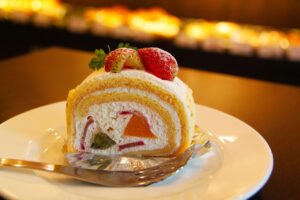
The Artistry of Cake Design
Cake design is more than just baking and frosting; it’s an art form that combines culinary skills with creativity and precision. It’s a way for bakers and cake artists to showcase their talents and create edible masterpieces that leave a lasting impression. Here are some key aspects that make cake design a unique art form:
1. Flavors and Aromas:
Cake design starts with the foundation—the cake itself. Bakers experiment with a wide range of flavors and aromas, from classic vanilla and chocolate to exotic combinations like lavender-honey or chai-spiced. The choice of flavors can set the tone for the entire design.
2. Structure and Support:
Building a multi-tiered cake that stands tall and stable requires a solid understanding of structural engineering. Cake designers use dowels, boards, and supports to ensure that their creations remain structurally sound.
3. Color Palette:
Just like any other form of art, color plays a crucial role in cake design. Palettes can be soft and pastel for a romantic wedding cake or vibrant and playful for a children’s birthday cake. Food-safe color gels and edible paints are used to achieve the desired hues.
4. Textures and Techniques:
Cake decorators employ various techniques to create textures and patterns. These can include smooth fondant coverings, intricate piping, marbling, ruffles, and even hand-painted designs.
5. Sculpting and Modeling:
For sculpted cakes that resemble objects or characters, cake artists use modeling chocolate, gum paste, and fondant to craft intricate details. These edible sculptures can be incredibly lifelike.
6. Edible Decorations:
From sugar flowers and edible gold leaf to isomalt gems and chocolate shards, edible decorations add the finishing touches that make a cake truly exceptional.
A Rich History of Cake Artistry
Cake design is a practice with deep historical roots. Cakes have been an integral part of celebrations for centuries, and their designs have evolved over time. Here’s a brief journey through the history of cake artistry:
Ancient Origins:
The concept of sweet, baked goods dates back to ancient civilizations like Egypt and Greece. These early cakes were often simple, sweetened with honey and flavored with nuts and fruits.
Medieval Europe:
In medieval Europe, cakes became more elaborate, with the addition of spices, dried fruits, and alcohol. These cakes were typically reserved for special occasions and celebrations.
The Victorian Era:
The 19th century saw the emergence of the modern wedding cake. Queen Victoria’s wedding cake, adorned with white icing, served as a model for future wedding cakes. The use of royal icing and intricate decorations became popular during this era.
20th Century:
The 20th century brought about significant advancements in cake design. Buttercream frosting and fondant, a pliable icing, were introduced. This allowed for smoother, more elaborate cake designs. The mid-20th century saw the rise of the tiered wedding cake, a trend that continues today.
Contemporary Cake Art:
Today, cake design has reached new heights of creativity and innovation. Cake artists push the boundaries of what’s possible, crafting cakes that resemble works of art. From gravity-defying designs to cakes that tell a story, the possibilities are endless.
Cake Design Techniques
Cake design is a creative endeavor, and there are countless techniques that can be used to make your cakes stand out. Here are some unique cake design techniques that can help you take your creations to the next level:
- Mirror Glaze: Mirror glaze is a stunning technique that creates a glossy, reflective surface on cakes. It involves pouring a colorful and transparent glaze over the cake, which creates a mesmerizing mirror-like effect.
- Isomalt Decorations: Isomalt is a sugar substitute that can be melted and molded into various shapes. It’s often used to create elegant, glass-like decorations for cakes, such as flowers, gems, or delicate sugar shards.
- Geode Cakes: Geode cakes mimic the beauty of natural crystals and geodes. These cakes feature a cavity filled with colorful, edible crystals created from sugar or rock candy, resulting in a striking and captivating design.
- Wafer Paper Flowers: Wafer paper is incredibly thin and can be shaped into delicate, lifelike flowers. These edible paper flowers can add an ethereal and artistic touch to your cake.
- Stenciling: Stenciling involves using food-safe stencils to create intricate patterns or designs on the surface of the cake. This technique is versatile and can range from classic to contemporary designs.
- Bas-Relief: Bas-relief is a sculptural technique where a design is raised slightly from the background. On cakes, it involves creating intricate, three-dimensional patterns or images on the surface of the cake, giving it a unique and textured appearance.
- Edible Metallics: Edible metallics, such as edible gold or silver leaf, edible metallic dust, or metallic food coloring, can be used to add a touch of luxury and shine to your cakes, creating a glamorous and eye-catching effect.
- Brush Embroidery: Brush embroidery is a technique where a fine brush is used to create delicate, lace-like patterns with icing on the cake’s surface. This technique is often used for creating vintage and romantic cake designs.
- Stringwork: Stringwork involves creating intricate, delicate strings or lines made of royal icing, which are suspended and woven around the cake to create intricate lace-like patterns and elegant designs.
- Chalkboard Cakes: Chalkboard cakes mimic the appearance of a chalkboard with edible chalk and vibrant chalk-like colors. It’s a unique way to add a personalized message or artistic design to your cake.
- Drip Effects: Drip effects involve letting colorful or contrasting ganache or icing gently drip down the sides of the cake, creating a contemporary and artistic look. This technique can add a pop of color and fun to your design.
- Edible Fabric: Edible fabric, such as edible lace or edible fabric sheets, can be used to create the appearance of fabric drapes, ribbons, or even lace overlays on your cakes, adding a touch of elegance.
These unique cake design techniques open up a world of possibilities for creating cakes that are not only delicious but also breathtaking works of art. Combining these techniques with your creativity and imagination can result in truly exceptional cake designs that leave a lasting impression.
The Sweet Satisfaction of Cake Design
Creating a uniquely satisfying cake design is a delightful art that combines aesthetics and taste. Here are some sweet satisfactions that come with cake design:
- Edible Masterpieces: Craftsmanship in cake design can produce edible masterpieces that are almost too beautiful to eat. The satisfaction lies in transforming simple ingredients into works of art.
- Surprise Inside: The thrill of cutting into a cake to reveal a surprise inside, whether it’s a hidden rainbow of colors, a heartwarming message, or a cascade of candies, is immensely satisfying.
- Texture Play: Combining textures in a cake is like a tactile adventure. The satisfaction is derived from the contrast between smooth fondant, crunchy nuts, creamy frosting, and tender cake layers.
- Color Symphony: Mixing and matching colors to create a visually stunning cake is a joy for the eyes. The blend of hues can evoke emotions and set the mood of the celebration.
- Personalization: Designing a cake to reflect the recipient’s personality, interests, or life events is a sweet satisfaction. It shows that you’ve put thought and care into the creation.
- Flavor Fusion: Experimenting with flavor combinations can lead to surprising and satisfying results. The fusion of unexpected tastes in a cake can be a delightful experience for the palate.
- Sculptural Elements: Adding sculptural elements to a cake, whether it’s intricate sugar flowers, delicate figurines, or geometric shapes, provides a sense of accomplishment and beauty.
- Nostalgia Factor: Creating a cake that brings back fond memories is deeply satisfying. It can transport people to a different time through taste and design.
- Interactive Cakes: Designing cakes that are not only visually appealing but also interactive, like a cake puzzle or a DIY decorating station, offers a unique form of engagement and satisfaction.
- Aroma and Taste: The ultimate satisfaction comes when the cake tastes as good as it looks. The blend of flavors, the moistness of the cake, and the harmony with the frosting is what makes cake design truly sweet.
- Themed Creations: Designing cakes based on a theme, whether it’s a favorite movie, book, or hobby, can be incredibly satisfying as it involves creativity and storytelling through the cake.
- Crowd’s Delight: The joy of watching people’s faces light up when they see and taste your creation is one of the most heartwarming satisfactions of cake design.
- Skill Growth: As you improve your cake decorating skills and master new techniques, the satisfaction of growth and self-improvement is both sweet and fulfilling.
- Memorable Moments: Cake design often becomes an integral part of memorable moments and celebrations. The satisfaction lies in knowing that your creation contributed to making a special day even more remarkable.
- Endless Creativity: The endless possibilities in cake design allow for boundless creativity. The satisfaction comes from knowing that you can dream up and bring to life virtually any design you envision.
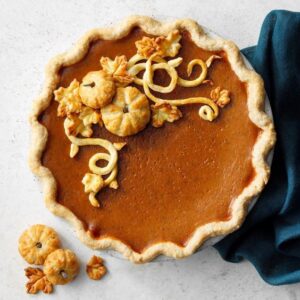
In the delightful world of cake design, every creation is a delectable story waiting to be told. As we wrap up this sweet journey through the art of cake design, it’s clear that these confectionery canvases are more than just desserts; they are edible expressions of love, creativity, and imagination.
Cake design is the perfect blend of visual aesthetics and tantalizing taste. With every cake, we paint memories, sculpt emotions, and craft experiences. The ability to turn a simple cake into an edible masterpiece, personalized to the finest detail, is a gift that keeps on giving, bringing joy to both creators and recipients.
From the texture play of fondant and frosting to the thrilling surprise hidden within, from the vibrant symphony of colors to the intricate details of sugar flowers and figurines, cake design is an art form that delights all the senses. It bridges the gap between nostalgia and innovation, tradition and novelty, making it a fascinating journey for both the baker and the lucky ones who get to savor these creations.
As we conclude this exploration of cake design, we’re reminded that the magic lies not just in the final slice but in the entire process, from the first stroke of a spatula to the last sprinkle of sugar. It’s a labor of love, a voyage through creativity, and a slice of happiness. Whether you’re a seasoned baker or someone simply appreciating these edible works of art, one thing is for sure: cake design is a delightful symphony of flavors and beauty, and its sweet satisfactions will continue to inspire and amaze for years to come. So, let’s raise our forks to the artistry, the craftsmanship, and the pure joy that is cake design.

